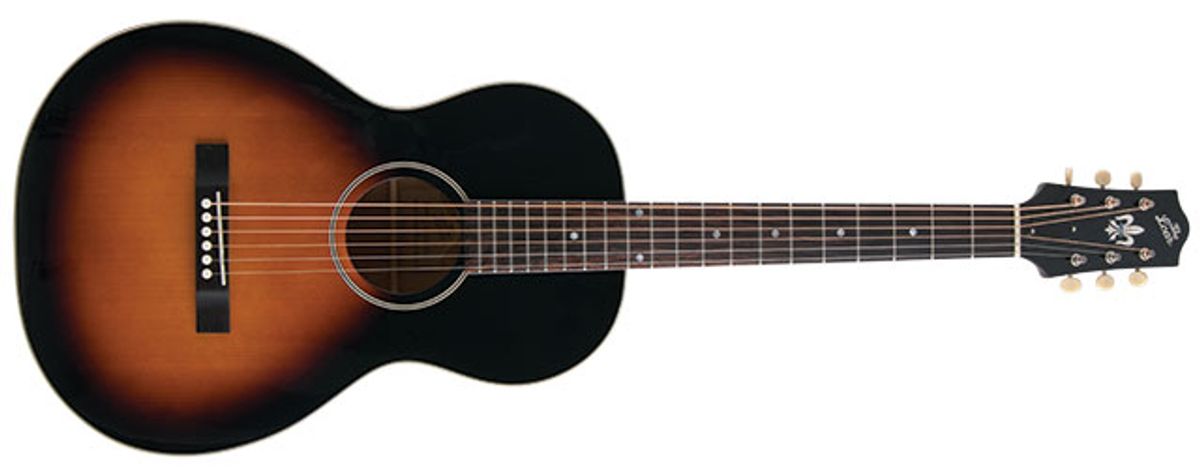The LO-215 is a country-blues machine that's percussive and snappy with a nice midrange honk that’s just plain funky.
0-sized bodies have been around so long (Martin introduced the first before the Civil War) that they have, just by virtue of being available, been used in making every kind of music imaginable. But they will likely remain, first and foremost, country blues and folk guitars in the estimation of most. With it’s dry and husky bark, the Loar LO-215 will do little to dispel that notion. But it’s a better guitar for those virtues and one of the more sonically interesting and fun-to-play guitars of our small-body bunch.
Like many of Loar’s guitars, the LO-215 is a very reverent interpretation of an early mid-century classic, and apart from the glossy, fresh-off-the-factory-floor look, feel, and smell, it appears to be a 70-year-old guitar at ten paces. The Loar is a pretty idiosyncratic guitar in many respects. The 25.4" scale is long, and the shallow heel would make the upper frets very accessible, except that with a 12-fret neck, most of them are impossible to reach.
Unusual for a small-body flattop, the Loar uses laminated maple on the back and sides, and the maple back has an almost tiger-stripe pattern that provides a surprising and pretty cool spoonful of flash. The fleur-de-lys headstock inlay is another classy touch. And the visual sum suggests a guitar more expensive than its sub-$400 street price.
Country Honk
The LO-215 could be the best country-blues machine of our roundup. It’s percussive and snappy with a nice midrange honk that’s just plain funky. It’s fantastic for John Lee Hooker-style thumb and fingerstyle blues, where you move from subdued chord rhythms to hot two-string leads and double-stops. The same qualities make it perfect for fast, syncopated rhythm playing. It’s responsive too, and boasts a perfect decay and dry-as-summer-hay midrange that makes funky chord vamps sound full of attitude without eating up a lot of a recorded or stage mix.
Ratings
Pros: Funky and versatile. Great playability.
Cons: Might prefer solid back and sides for $450.
Tones:
Playability:
Build/Design:
Value:
Street: $449
theloar.com
The guitar’s playability also makes barre chords inviting. And playing a barred E-chord at the 7th fret generates a tight, growling tone that’s ideal for driving rock rhythm tracks or ringing Keith Richards-style stabs.
A very hip nasal and compressed voice makes percussive, thumb-driven pentatonic leads sound full of intent. It can be pretty brash in the high-mids when you push it hard with a flatpick, and in general, single notes have a kind of compressed, compact resonance. But if you’re looking for a different approach to the same old blues lead, this guitar could be just what the witch doctor ordered.
As good as the Loar is at country blues textures, it’s not a one-trick pony. The dulcimer-like aspects of the guitar’s tone palette work well for Celtic picking. The dry attack is also perfectly suited for driving Gypsy-jazz comping or jazzier vocal accompaniment.
Unless you’re really used to the boxy, succinct, and dry tones of a small body like this, it can take a few jams to learn how to respond to the Loar’s strengths. But they are numerous and capable of wildly varied applications. As a composing tool, it has a distinct voice that can steer you out of standard folk phrasing. And it can surprise in the studio, deliver as a rock rhythm machine without sounding too boomy, or lend a funky individuality to a blues lead. It may not be the only guitar you’ll have at hand on a session, but for just around 450 bucks, it’s a second guitar option you almost can’t afford to be without.
Watch our video demo:
Read the rest of the reviews in the roundup:



